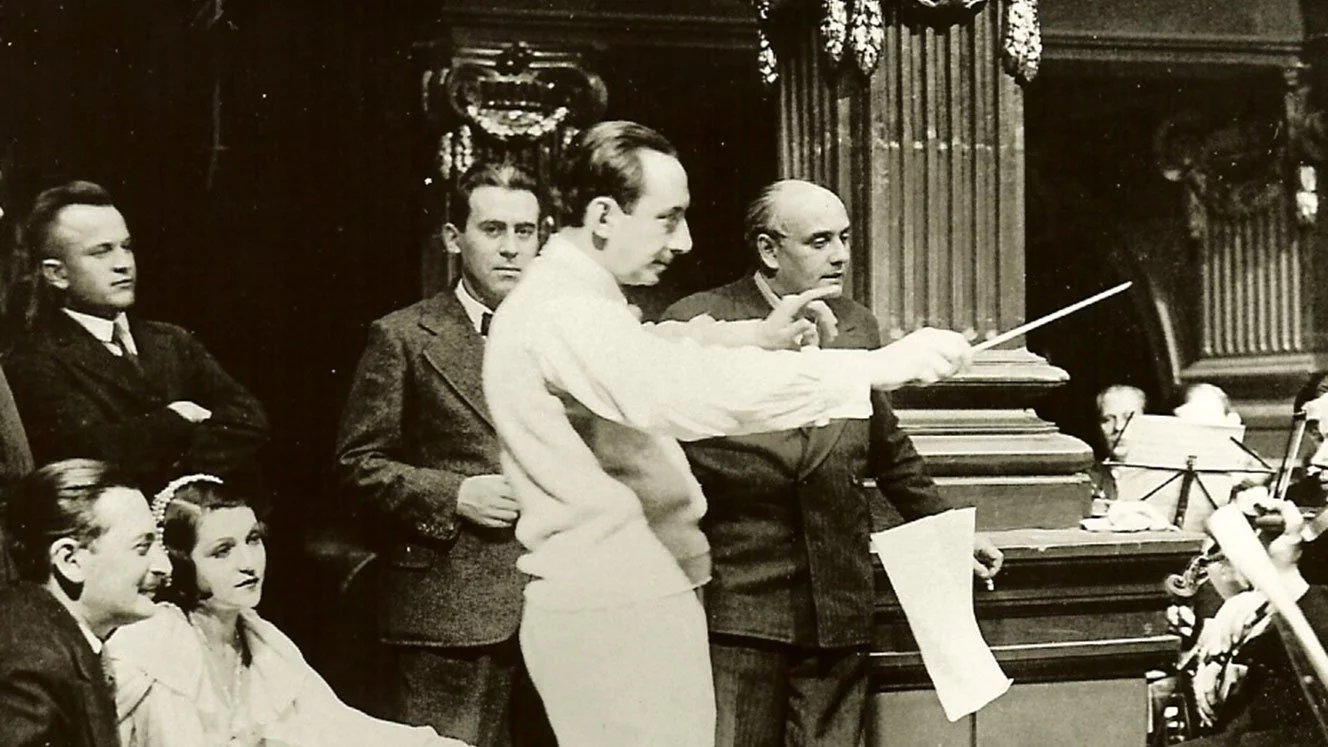- History

23 years old and already performed by the Berliner Philharmoniker. What sounds improbable to us today was actually not uncommon in the 1920s. Kurt Weill was exactly that age when the Philharmonic premiered his Fantasy, Passacaglia and Hymn in March 1923. Even if the piece was lacking in “larger ideas” – as one critic opined in the magazine Signale für die musikalische Welt – there was no doubt that its author was a “talent”. Richard Heymann, whose Rhapsodic Symphony for large orchestra and baritone solo was performed at a Philharmonic concert in December 1920, earned a similar judgment, and the reviewer went on to write that “Heymann is basically a melodist at heart”. The then 23-year-old composer’s work had been introduced by two renowned performers: Leipzig’s celebrated general music director Gustav Brecher and the baritone Wilhelm Guttmann.
Kurt Weill and Werner Richard Heymann belonged to a generation of young composers on the threshold of breathtaking careers. Another was Friedrich Hollaender, who in those days was co-director with Heymann of “Schall und Rauch” (Sound and Smoke), the cabaret founded by Max Reinhardt. The three had in common not only talent, creativity and musical inventiveness but also their Jewish heritage.
A finger on the pulse of the time
Although they were really looking to make their names in the field of “serious” music, Berlin’s dizzying operetta, revue, variety, cabaret and film scene in the 20s offered composers like these sufficient opportunities to develop and try out new musical formats. With the advent of the talkies, a further sphere of activity came into existence. Friedrich Hollaender and Werner Richard Heymann were among the founding fathers of sound film. While Hollaender was enjoying success with abstruse and highly charged cabaret songs such as Oh Mond (Oh Moon) and Die Kleptomanin (The Lady Kleptomaniac), as well as the songs in Der blaue Engel (The Blue Angel), Heymann was delighting the public with his scores for the movies Melodie des Herzens (Melody of the Heart), Liebeswalzer (Waltz of Love) and Die drei von der Tankstelle (Three from the Filling Station).
This “melodist” created the rousing hit Ein Freund, ein guter Freund (A Friend, A Good Friend), the romantic song Liebling, mein Herz lässt Dich grüßen (Greetings from the Heart, Darling) and the melancholy standard Irgendwo auf der Welt gibt’s ein kleines bisschen Glück (Somewhere in the World). His songs’ special combination of romance, irony and distance perfectly encapsulated the zeitgeist. “You don’t know me, but you’ve already heard a lot about me”: at the end of the 20s, Werner Richard Heymann liked to introduce himself with those words. Kurt Weill, on the other hand, became famous through his innovative music-theatre collaborations with Bertolt Brecht Die Dreigroschenoper (The Threepenny Opera) and Aufstieg und Fall der Stadt Mahagonny (Rise and Fall of the City of Mahagonny). With his implacable, laconic musical language, he also had his finger on the pulse of the time. There was a whole array of Jewish-born composers who dazzled Berlin with musical entertainment during the Roaring Twenties, also including Paul Abraham, Mischa Spoliansky and Franz Wachsmann.
An abrupt ending
For all of them, the 20s were truly a “Golden Age”: inspiring, enthralling, flourishing. But that all changed. After the Nazis seized power, there were suddenly no possibilities of work for these “non-Aryans”. Only emigration was left. Most of them went to America hoping to replicate their European success, but that usually proved harder than they anticipated. For Paul Abraham, exile was especially disastrous. Having contracted syphilis, he suffered a nervous breakdown and spent years in an American mental hospital before he was able to return in 1956 to a relatively secure life in Germany under the auspices of a friend, admirers and the government. Heymann, Hollaender and Wachsmann did find their way in the Hollywood studios, though eventually only Wachsmann would stay on in the US. As Franz Waxman, he became one of the most successful of all film music composers. And Kurt Weill, too, managed to establish a new career in America – as a composer of Broadway musicals.
Epilogue
And what became of the conductor Gustav Brecher and the baritone Wilhelm Guttmann, who took part in the performance of Heymann’s Rhapsodic Symphony and were also of Jewish descent? Brecher, relieved of his post as Leipzig music director in 1933, escaped from the Nazis to Belgium but in 1940, following that country’s German occupation, took his own life. Guttmann, who had just been severely abused in an interrogation by the Gestapo in 1941, collapsed and died onstage during a song recital.